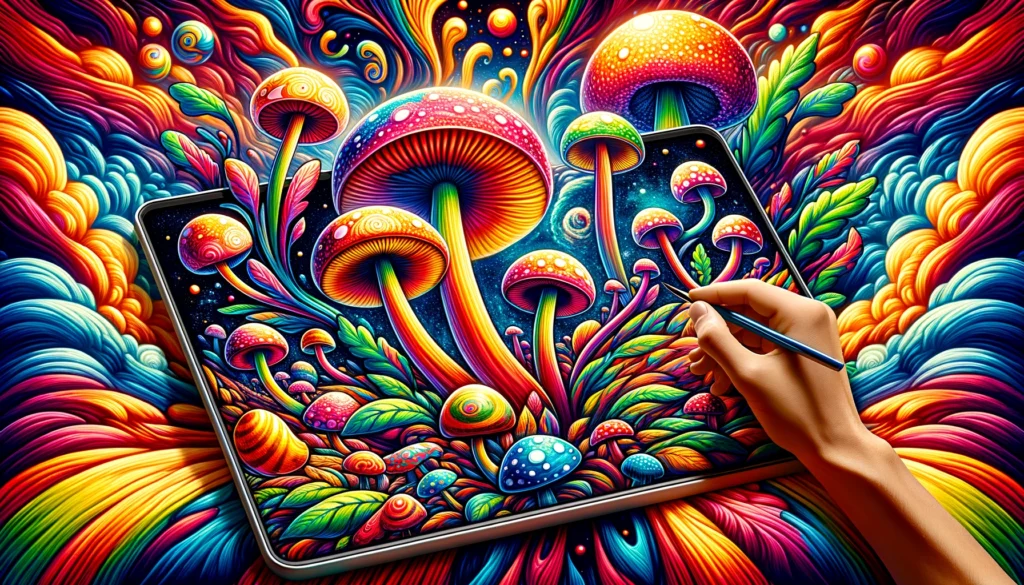
How to draw a trippy mushroom
Dive deep into the vibrant world of psychedelic art with our comprehensive guide on drawing trippy mushrooms. From basic sketches to advanced techniques, we’ll walk you through every step of creating mesmerizing, colorful fungi that capture the essence of the psychedelic experience. Whether you’re a novice artist or looking to add a new dimension to your work, this guide is your doorway to mastering the art of trippy mushrooms.
1. Understanding Trippy Mushrooms
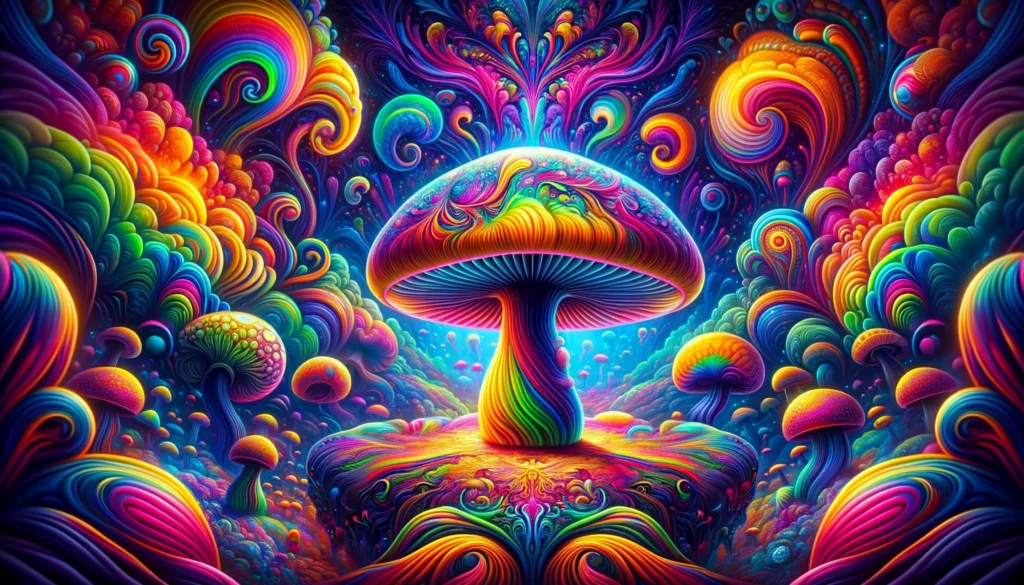
Cultural and Artistic Significance
Trippy mushrooms, often synonymous with psychedelic mushrooms, hold a profound place in psychedelic art and culture. These fungi are not only celebrated for their hallucinogenic properties but also revered for their unique aesthetic, which has inspired artists and creatives for decades. The allure of trippy mushrooms stems from their ability to evoke feelings of wonder, transcendence, and a deeper connection with the mystical aspects of nature.
What Makes a Mushroom “Trippy”?
A trippy mushroom is characterized by its vibrant colors, intricate patterns, and the surreal environments it is often depicted in. These features make it a perfect subject for psychedelic and fantasy art, where the boundaries of reality are expanded, and the imagination is free to explore.
Visual Characteristics
- Vibrant Colors: Bright and often neon colors that stand out against more subdued backgrounds.
- Intricate Patterns: Spirals, dots, and wavy lines that mimic the natural patterns found on mushroom caps and stems, but amplified for a psychedelic effect.
- Surreal Environments: Settings that defy the laws of physics and logic, enhancing the trippy aspect of the mushroom.
Varieties of Mushrooms in Psychedelic Art
Psilocybe Cubensis
- Appearance: Often depicted with a golden cap and a slender, ivory-colored stem.
- Symbolism: Represents transformation and enlightenment, common themes in psychedelic narratives.
Amanita Muscaria
- Appearance: Iconic for its bright red cap with white spots.
- Cultural Significance: Has a deep-rooted presence in folklore and myth, symbolizing magic and mystery.
The Role of Mushrooms in Psychedelic Art
Trippy mushrooms serve as a bridge between the seen and the unseen, the known and the unknown. They are a powerful symbol in psychedelic art, representing the mind’s ability to transcend ordinary reality and explore the depths of consciousness. Artists who incorporate these mushrooms into their work often aim to capture the essence of the psychedelic experience—a journey of self-discovery, expansion of consciousness, and a deeper understanding of the interconnectedness of all things.
In creating art that features trippy mushrooms, artists tap into a rich tapestry of symbolism and mythology, inviting viewers to consider broader perspectives and question the nature of reality. This art form encourages open-mindedness, curiosity, and a willingness to explore the unknown.
Explore our curated selection of trippy wall art, perfect for adding a psychedelic touch to any room.
2. Materials Needed
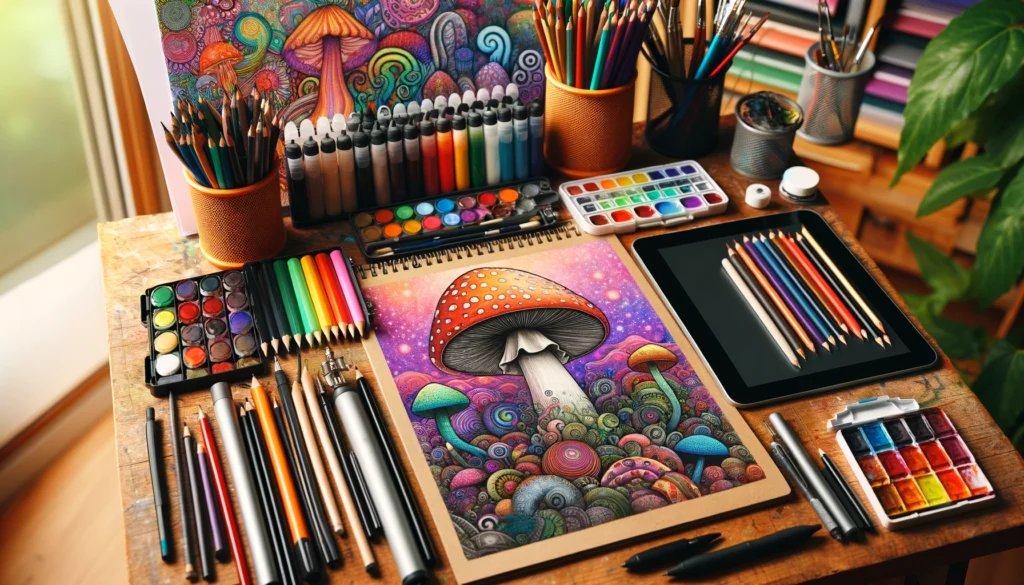
Selecting Your Tools
The journey to creating a trippy mushroom begins with gathering the right materials. Your choice of tools can significantly impact the final outcome, offering different textures, effects, and levels of detail that enhance the psychedelic experience of your artwork.
Drawing Tools
- Pencils: A range of pencils from HB for light, sketchy lines to 2B and 4B for darker, more defined lines. Pencils are essential for sketching the initial outlines and adding fine details.
- Fine Liners: Ideal for defining sharp, precise lines that bring clarity and distinction to your trippy designs.
- Markers: Provide vibrant, even coverage of color. Alcohol-based markers are particularly favored for their smooth application and ability to blend colors seamlessly.
Coloring Supplies
- Watercolors: Offer a translucent quality, allowing for subtle gradients and a dreamlike atmosphere. Perfect for backgrounds or soft color transitions.
- Colored Pencils: Great for adding detail and texture. Their ability to layer and blend colors can be used to achieve depth and vibrancy in your psychedelic artwork.
- Acrylic Paints: With their thick consistency and bold colors, acrylics are excellent for making your trippy mushroom stand out against the canvas.
Paper and Surfaces
- High-Quality Sketch Paper: A must-have for any artist. Look for paper with a good weight (around 100-140 gsm) that can handle both pencil and ink without bleeding or warping.
- Watercolor Paper: If you’re using watercolors, this type of paper is essential. Its texture and weight (300 gsm or higher) are designed to absorb water without buckling.
- Canvas: For acrylic painters, a pre-primed canvas provides a sturdy surface that showcases the vibrant colors and dynamic textures of psychedelic art.
Digital Tools (Optional)
For those who prefer the digital canvas, a drawing tablet and stylus offer infinite possibilities. Programs like Adobe Photoshop or Procreate come with a vast array of brushes and tools that simulate traditional media, alongside unique digital effects that can take your trippy mushroom designs to another dimension.
Dive into the vibrant world of trippy wall art and discover pieces that will transform your space
3. Basic Shapes and Outlines
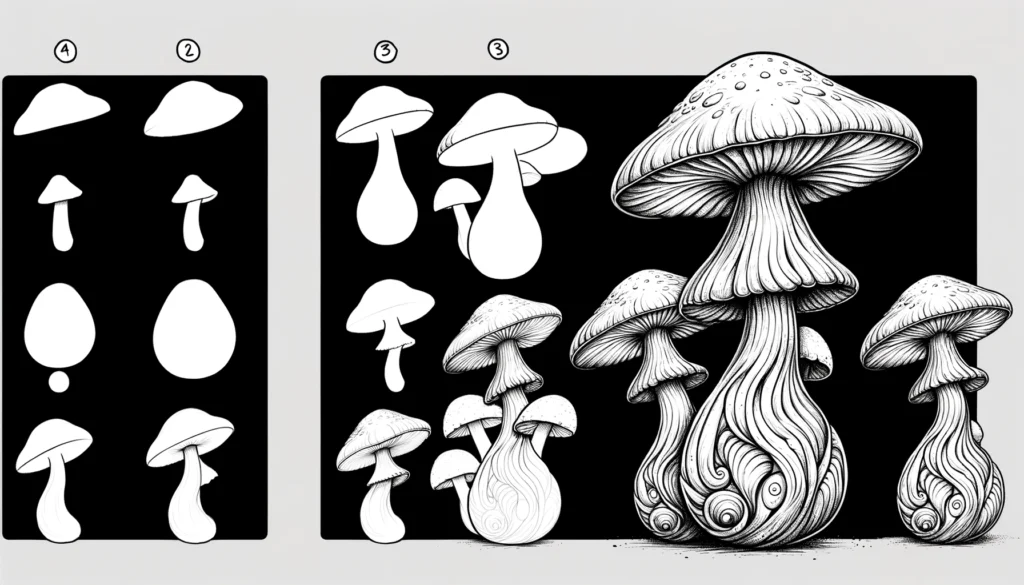
Creating a trippy mushroom artwork begins with understanding and drawing the basic shapes and outlines. This foundational step is crucial for establishing the structure of your mushroom, ensuring accuracy in proportion and perspective before advancing to more detailed and colorful stages.
Sketching the Basic Shape
Step 1: The Cap
- Start with the mushroom cap, which is often the most distinctive part of the mushroom. Draw a broad, curved line for the top of the cap and a slightly curved line underneath to represent the underside. This creates a basic dome shape, which can be adjusted to depict different types of mushrooms.
Step 2: The Stem
- Draw a cylindrical shape beneath the cap for the stem. The width of the stem can vary depending on the type of mushroom you’re drawing. Some trippy mushrooms feature thin, elongated stems, while others have thicker, more robust stems.
Adding Dimension and Perspective
To transform your basic sketch into a more three-dimensional form, it’s essential to apply principles of dimension and perspective.
Creating Depth
- Slightly angle the lines of the cap and stem to suggest depth. For a more dynamic composition, consider tilting the cap or bending the stem.
Perspective Techniques
- Use shading and contour lines on the cap and along the stem to suggest volume. Highlighting and shadowing these areas can enhance the trippy effect by giving the illusion of light reflecting off the mushroom’s surfaces.
Refining the Outline
With the basic shape and perspective established, refine your sketch by cleaning up any unnecessary lines and sharpening the details. This refined outline serves as a guide for adding colors, patterns, and other psychedelic elements in later stages.
Detailing
- Add texture to the stem and the underside of the cap, where gills or pores might be visible. These details contribute to the realism and intricacy of your trippy mushroom, making it a compelling focal point in your artwork.
4. Adding Trippy Elements
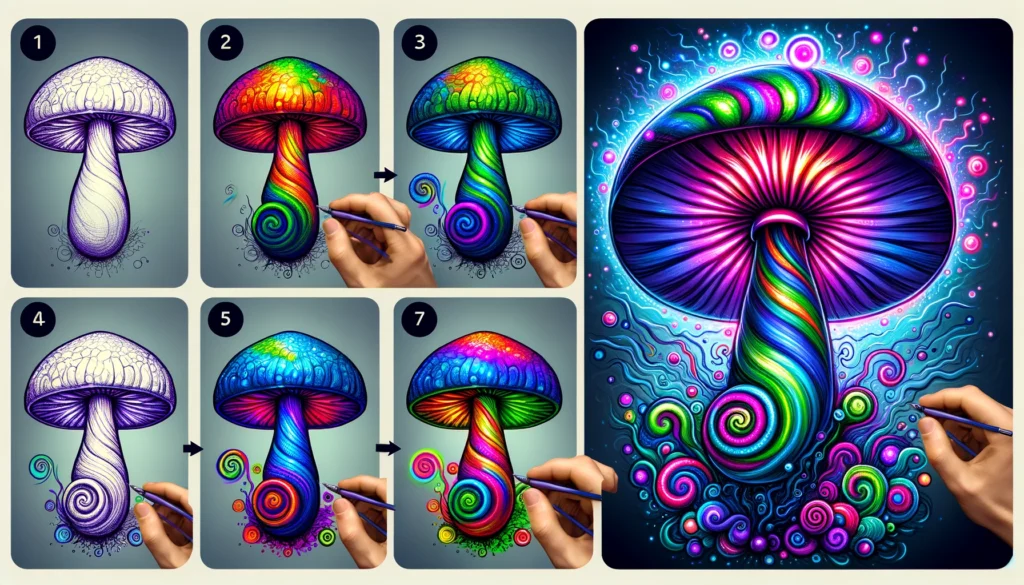
To transform a simple mushroom sketch into a trippy masterpiece, incorporating psychedelic elements is key. This section focuses on infusing your artwork with vibrant colors, intricate patterns, and dynamic textures that resonate with the essence of psychedelic art.
Incorporating Psychedelic Patterns
Spirals and Fractals
- Spirals and fractals are hallmarks of psychedelic imagery, symbolizing the infinite complexity of the natural world. Integrate these patterns into the mushroom cap, stem, and surrounding areas to add a sense of movement and depth.
Wavy Lines and Dots
- Incorporate wavy lines to suggest fluidity and motion, while dots can add texture and visual interest. These elements are particularly effective on the mushroom cap and can be used to highlight contours and create a trippy effect.
Using Color Theory
Vibrant and Contrasting Colors
- Selecting vibrant colors that contrast well with each other can make your artwork pop. Think neon greens, electric blues, hot pinks, and vivid purples. These colors not only attract the viewer’s eye but also enhance the psychedelic vibe of your piece.
Color Blending Techniques
- Mastering color blending is crucial for achieving smooth transitions between hues, adding dimension and a dreamlike quality to your mushroom. Experiment with different mediums to see how they blend, using tools like blending stumps, water brushes, or digital blending tools for those working on a tablet.
Adding Depth with Shading and Lighting
Shading Techniques
- Use shading to create volume and depth, making your mushroom appear three-dimensional. Pay attention to the light source in your composition, and shade accordingly to enhance the trippy atmosphere.
Lighting Effects
- Consider adding exaggerated or fantastical lighting effects, such as a glowing aura around the mushroom or reflective highlights that suggest a mysterious light source. These effects can elevate the surreal quality of your artwork.
5. Advanced Techniques
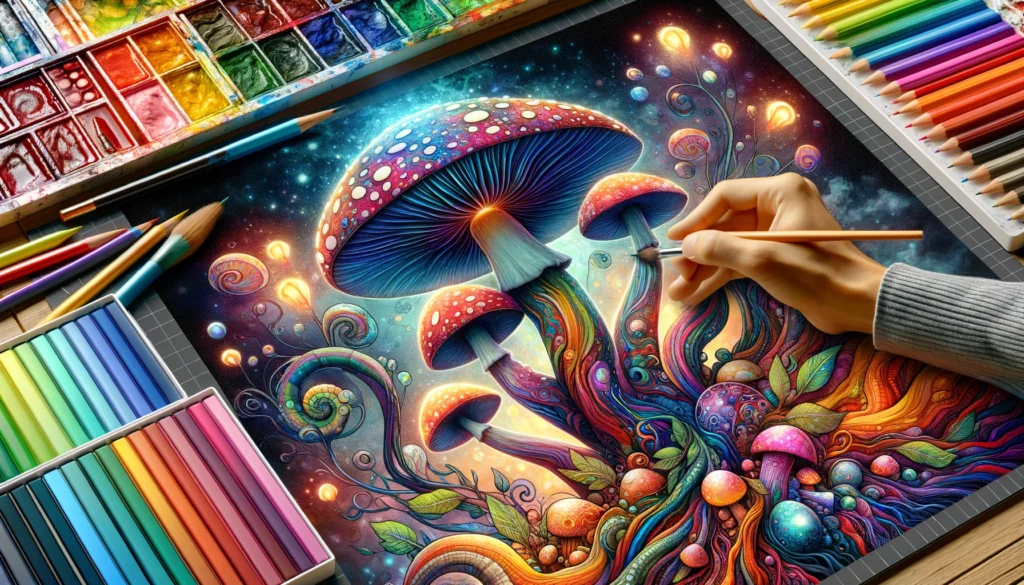
Elevating your trippy mushroom artwork involves integrating advanced techniques that add complexity, depth, and a touch of magic. These methods are designed to push the boundaries of traditional drawing, allowing artists to explore new textures, effects, and digital enhancements.
Mixed Media for Texture and Depth
Combining Materials
- Using a combination of pencils, inks, paints, and even non-traditional materials can introduce varied textures and effects. For instance, layering watercolor under acrylic highlights can add a translucent quality to your piece, while colored pencils can provide fine details that bring the trippy elements to life.
Textural Effects
- Experiment with techniques like sponging, splattering, or using masking fluid to create unique patterns and textures. These effects can simulate the organic, unpredictable nature of psychedelic visuals, enhancing the overall impact of your artwork.
Digital Art Tips for Trippy Mushrooms
Layering and Blending
- Digital platforms offer unparalleled control over layering and blending, enabling artists to experiment with colors and textures without the limitations of physical media. Utilize layers to separate different elements of your drawing, making it easier to adjust colors, patterns, and effects independently.
Custom Brushes and Effects
- Take advantage of custom brushes and effects available in digital art software. Brushes that mimic natural media or offer psychedelic patterns can add authenticity and flair to your trippy mushroom designs.
Experimenting with Lighting and Glow Effects
Glow Techniques
- Adding glow effects, especially in a digital format, can make your trippy mushroom appear as if it’s emitting light. This can be achieved by layering soft, bright colors around the mushroom, using blending modes such as “Screen” or “Add” to create a luminous effect.
Dynamic Lighting
- Consider how lighting interacts with your subject and its environment. Experiment with unusual light sources, such as bioluminescence or otherworldly glows, to enhance the mystical and psychedelic feel of your artwork.
For those who appreciate the beauty of psychedelic visuals, our trippy wall art collection offers the perfect expression.
6. Finishing Touches
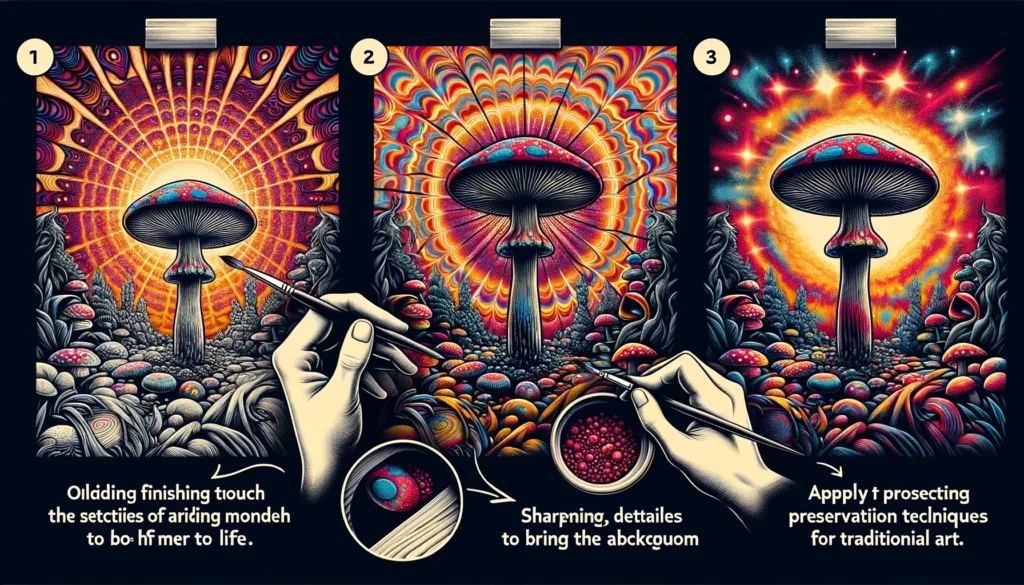
The final stage in creating a trippy mushroom artwork involves adding those last-minute adjustments and enhancements that elevate the piece from great to truly spectacular. This phase is crucial for polishing your work and ensuring that every element contributes to the overall psychedelic experience.
Enhancing Your Drawing with Background Elements
Choosing a Background
- The background can significantly impact the mood and depth of your artwork. Consider using abstract patterns, cosmic landscapes, or surreal forest scenes to complement your trippy mushroom. The background should not overpower the main subject but rather enhance its psychedelic qualities.
Integration Techniques
- Ensure that your mushroom blends seamlessly with the background by adjusting colors, shadows, and lighting. This can involve softening edges, adding background elements that reflect the mushroom’s colors, or incorporating light sources that affect both the mushroom and its surroundings.
Cleaning Up Your Artwork
Erasing Unnecessary Lines
- Carefully erase any sketch lines or marks that are no longer needed. This step is especially important in traditional media but also applies to digital work, where clean-up can involve removing stray pixels or smoothing edges.
Sharpening Details
- Go over your piece to emphasize important details that may have been lost during coloring or blending. Use fine-tipped pens or a small brush to redefine edges, enhance textures, and add small highlights or shadows that give life to your trippy mushroom.
Preservation and Display
Protecting Traditional Art
- If your artwork is on paper or canvas, consider using a fixative spray to protect it from smudging and fading over time. For pieces that are particularly important or valuable, framing behind UV-protective glass can offer additional protection.
Digital Art Considerations
- For digital works, ensure that your final piece is saved in high-resolution formats suitable for printing or online display. Back up your files in multiple locations to safeguard your artwork against data loss.
Elevate your home decor with our exclusive trippy wall art, featuring mesmerizing designs and colors.
7. Inspiration and Resources
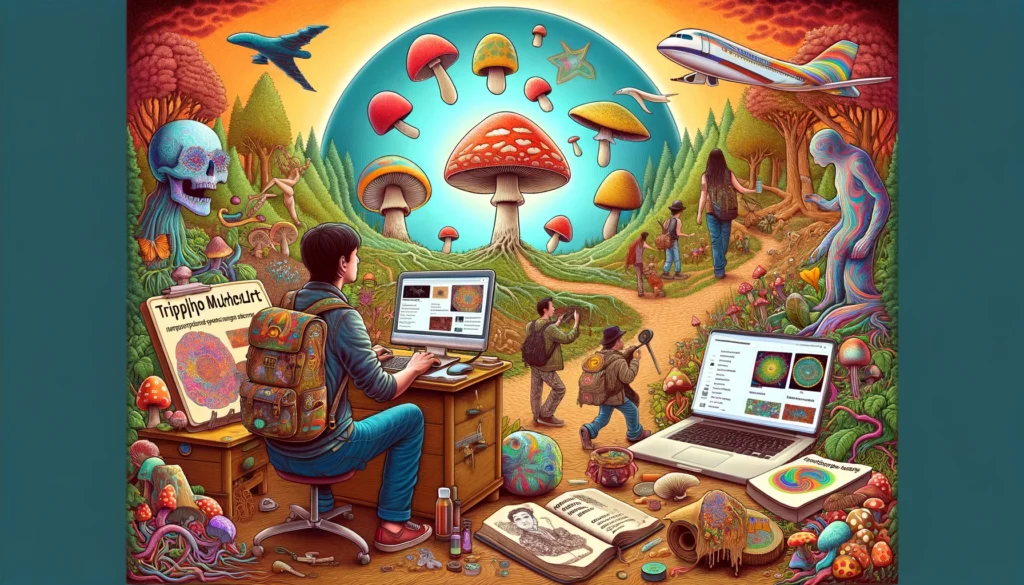
Finding inspiration and the right resources is crucial for artists seeking to explore and excel in creating trippy mushroom art. This section provides guidance on where to look for inspiration and which resources can help you refine your skills and deepen your understanding of psychedelic art.
Drawing Inspiration from Nature
Studying Mushrooms in Their Natural Habitat
- Observing mushrooms in nature can provide invaluable insights into their forms, textures, and colors. Take note of the environment, the way light plays on their surfaces, and the variety of shapes and sizes. These observations can enrich your psychedelic artwork with authenticity and detail.
Photography and Illustrations
- Collecting photographs or botanical illustrations of mushrooms can serve as direct reference material for your art. Pay attention to the intricate details and patterns that make each species unique.
Exploring Psychedelic Art and Artists
Historical Movements
- The psychedelic art movement of the 1960s and 70s, with its vibrant colors, fluid forms, and trippy motifs, provides a wealth of inspiration. Research artists from this era to understand the origins of psychedelic aesthetics.
Contemporary Artists
- Many modern artists continue to explore and expand the boundaries of psychedelic art. Platforms like Instagram and Behance are great places to discover contemporary artists whose work can inspire your own.
Utilizing Online Tutorials and Art Communities
Tutorials
- Online platforms offer tutorials ranging from basic drawing techniques to advanced digital painting. YouTube, Skillshare, and Udemy are excellent resources for learning specific skills related to creating trippy mushroom art.
Art Communities
- Joining art communities such as DeviantArt, ArtStation, or Reddit’s r/Art can provide feedback, encouragement, and new ideas. Participating in these communities allows you to share your work, see what others are creating, and engage in discussions about art techniques and concepts.
Books and Literature
Art Theory and Mushroom Guides
- Books on art theory can deepen your understanding of color, composition, and design, which are all crucial for creating impactful psychedelic art. Additionally, field guides to mushrooms offer scientific insights that can inspire more accurate and detailed representations.
Embarking on this artistic journey, you’ve unlocked the mysteries of creating trippy mushroom art that transcends the ordinary. With these skills, your artwork will not only captivate and inspire but also pay homage to the boundless creativity that psychedelic art embodies. Continue to explore, experiment, and elevate your art, for every mushroom you draw is a portal to new realms of imagination.